Planting Trees In Ghana
Click A Tree Project Introduction
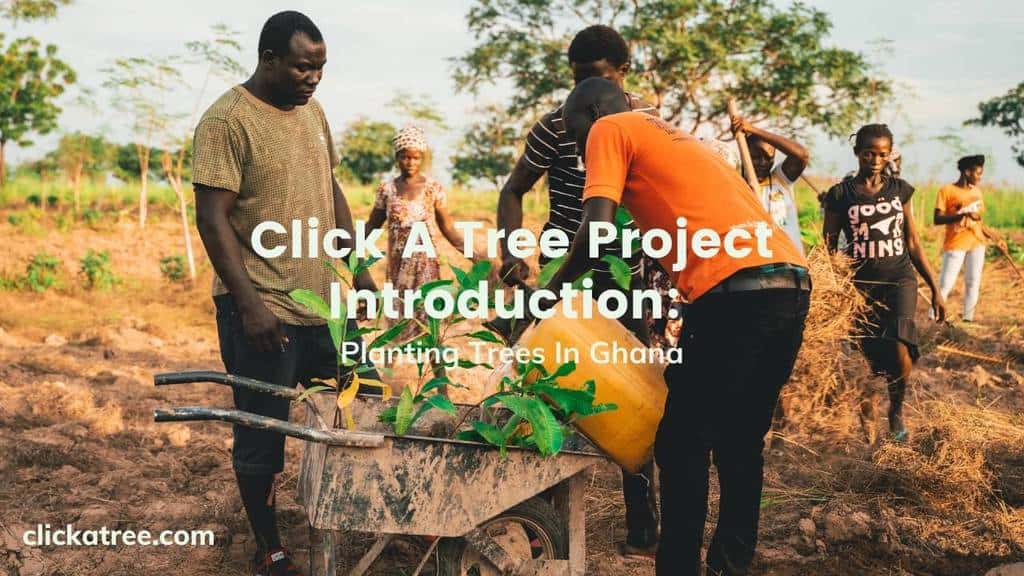
We’ve just kicked off a brand-new project planting trees in Ghana! And today, we’re going to give you a quick introduction to the exciting new project that’s underway and explain a little bit about how it works. Keep on reading to find out.
Local Life Planting Trees in Ghana
Imagine hearing the crackling sound of a bonfire in the remote Ghanaian countryside. The Milky Way yawns above you and the night still smells of the day’s fresh rain. Faces are warm, alive, and lit up around the ember. There are smiles everywhere you look, with pairs and pairs of gleaming eyes all happy to be there.
Imagine one quiet voice begins to recite a local song. The words are an invitation to join the celebration and before long, there are several more mouths erupting into harmony. Beautiful baritones, tenors, choirs singing together.
Imagine those same songs continued until morning. Imagine you found a community truly together, working as a team, getting so much joy from their everyday work. They’re happy to wake up early and earn a living, knowing that they’re helping to create a promising future. They can sell delicious fruits, protect wildlife, and educate their village.
But you don’t have to imagine any of this. You just need a plane ticket to West Africa. This is local life now at our tree-planting location in Ghana.
Where Are We Planting Trees In Ghana?
Country Profile
Ghana is a country in North-Western Africa. It’s nestled between Ivory Coast and Togo, sharing the Atlantic coastline with its neighbors.
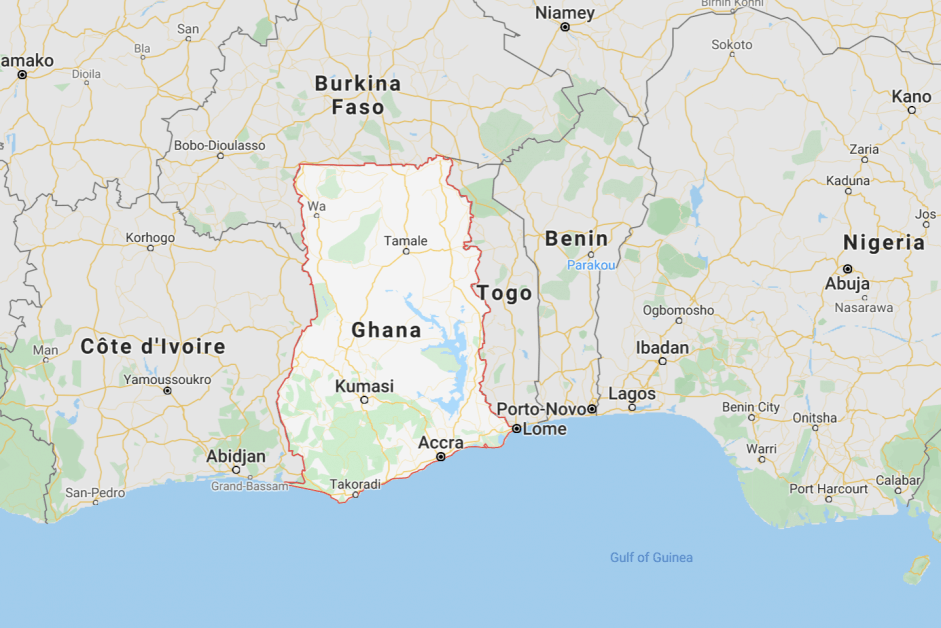
There are 29 million inhabitants (that’s 128 per square kilometer) in a country which is roughly the same size as the United Kingdom (although the UK has more than double the number of inhabitants).
Incidentally, Ghana gained its independence from Great Britain as recently as 1957. However, it ranks low on the UN Human Development Index, languishing in lowly position number 138.
Comparatively, Germany ranks number 6, with the UK number 13. Despite being considered ‘one of the more stable countries in West Africa’, it’s still a nation where workers desperately require sustainable, reliable income.
Our Tree Planting Location
More than 1,000 acres of old farmland are available in the Volta Region of Eastern Ghana. Specifically, our tree-planting site is close to Kyinderi – 10 hours North of Accra, the country’s capital, 5 hours South of Tamale.
Why Are We Planting Trees In Ghana?
Our Tree-Planting Mission
As we’ve already mentioned, this beautiful African country needs investment. Planting trees in Ghana may not solve every single problem currently facing the nation, but it’s a pretty good start.
Our mission is to create long-term, sustainable, and full-time employment for local people in Ghana. This work will ensure food security for local farmers while also reforesting badly damaged land.
The work will benefit local people and their community. But there will also be a long-term benefit for the land, the animals that rely on trees to survive, and the next generation in the area.
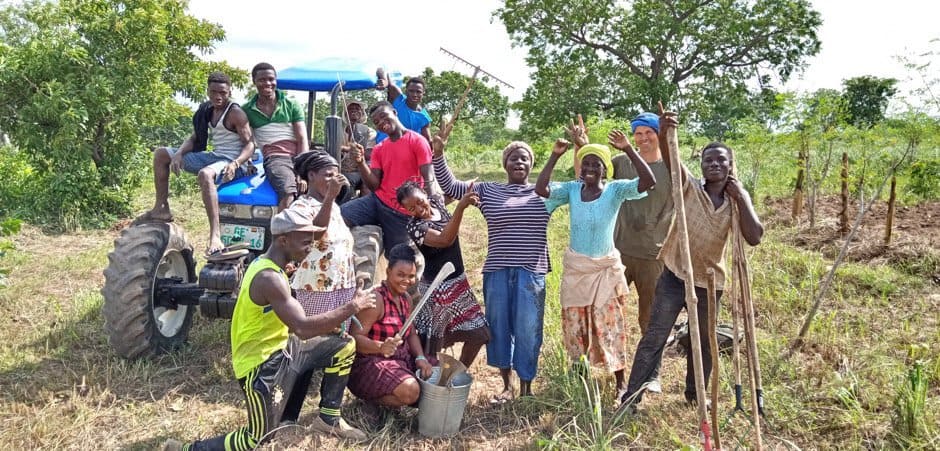
Eager to plant a tree right away? No problem, it only takes a couple of clicks!
What Else Is Involved?
Besides creating full time jobs and reforesting Ghana, the work also supports the entrepreneurship school (established in 2018) for unemployed youths in the village.
Some years ago, a visionary villager called Clement noticed some issues with unemployment. There were few opportunities and there was little chance of any type of career in the local area. He envisioned changing this by creating jobs for the villagers, and offering education to the youngsters.

With the entrepreneurship school, he made his dream a reality. Young people can build a better future for themselves here. 18-to-25-year-olds get a basic education in computing knowledge, develop relevant business ideas, and work on specialist projects. They learn about soft- and hardware, accounting, public speaking and get business English and math lessons.
In addition, they gain farm work experience, build bio-toilets, learn the art of bee-keeping, tractor operating, composting and craft artisanal products from beads, cloths and local materials.
And all of that for free! Some even receive food and board as well – at no cost to them.
In return for their education, these young people work on the tree-planting farms. This continues the cycle of keeping their education free and new trees growing.
So by planting trees in Ghana, you’re not just doing something great for our planet. You also actively help finance the education of unemployed young people, who can then build a better future for themselves and for their families. How good is that?
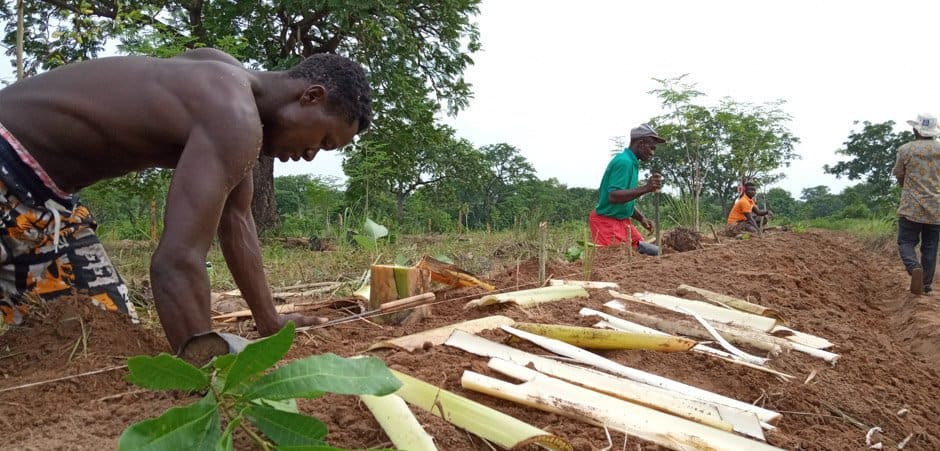
How Are We Planting Trees In Ghana?
Syntropic Farming
Has everybody got their biology books ready? No? No worries, we’ll keep this one simple.
Our tree-planting work in Ghana uses the Syntropical Farming and Reforestation strategy as outlined by Ernst Götsch. If you really want to learn about Syntropic Farming in more detail, then feel free to follow this link. (Syntropic farming is also closely related to forest farming or agroforestry.)
Or watch this short video by Ernst Götsch himself, explaining Syntropic Farming:
And, if you don’t have time today, then think of this farming technique as a modern, highly advanced reforestation plan. It’s a multidisciplinary process which focuses on reforestation in the same way that Mother Nature would: We basically build a farm into a forest.
The Reforestation Structure
Using this technique, the growth of new trees is combined with sustainable, organic farming.
This means that while long-term reforestation plans continue to develop, there are also some immediate benefits that become apparent much sooner.
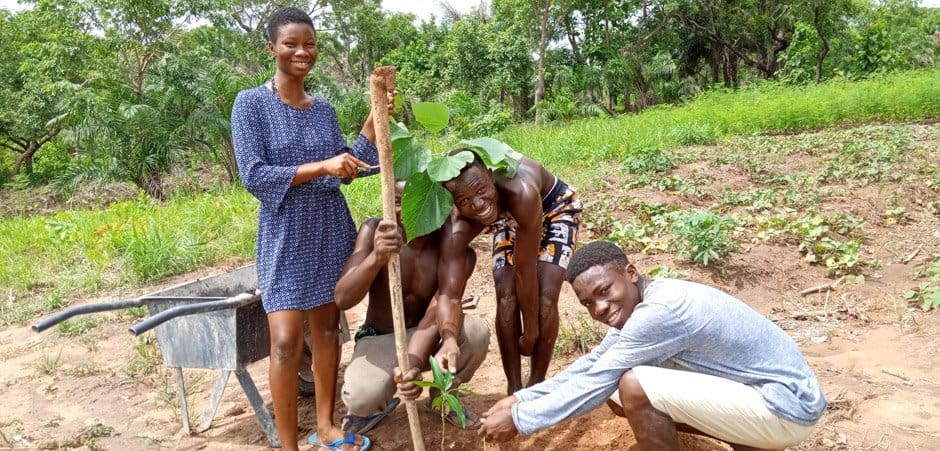
Seedlings are planted with a plan in mind. For example, large trees (let’s call them jungle trees) are planted around 6 meters apart. Usually, three other smaller trees (we’ll call them farm trees) are planted between these two large trees.
The larger trees are placed this far apart so that they can fully develop and later create jungles and forests. The smaller trees grow faster than larger trees, and could be either banana trees, moringa trees, or gmelina trees. All of them will quickly grow and produce valuable fruits and leaves. Farmers can then sell these products while the larger trees continue to develop.
But there’s a fascinating biological benefit as well. After two years the stems from banana trees, in particular, can also help to regulate the water cycle in the soil and keep everything moist. These stems are covered in mulch, before absorbing the water and giving it back to the ground in a process that is vital for the water consumption of other trees.
Gmelina trees help to create that nutritious mulch. However, they also create natural biomass with their impressively big leaves.
The farm trees and jungle trees are perfectly suited to growing together with both short-term and long-term advantages.
Small Scale Farming
That sounds too good to be true, doesn’t it? Incredibly, there’s even more.
In-between all these rows of trees, green grass grows as well. Cows feed on that grass (don’t worry – they don’t harm the trees) and leave behind their manure. Next, rabbits are allowed to feed on the grass and leave their droppings behind too.
Finally, chickens will feed on the grass. By the time they do that, larvae will be growing from the old cow manure. The chickens help to spread the manure by picking for the larvae, and, you guessed it, they leave behind their droppings too.
All of this helps to fertilize the soil and feed the whole system. There’s more nutrition on the ground, and that creates a healthier soil for the trees to feed on.
Which Tree Species Do We Plant?
We’ve already mentioned that we plant moringa trees on our Ghanaian farm. Their leaves have many positive uses, similar to the banana trees that we grow. On top of that, we also plant sheanut trees and nim trees.
But we’re also growing larger trees like mahogany trees, and even baobab trees! These enormous trees can grow as old as 3,000 years old. Their trunks can eventually reach up to 10m in diameter, towering above the forest. But that’s only if they’re well-looked after in the beginning: Baobabs are taken care of for about 12 years!
Want to know more about baobab trees? Check out these 7 facts about Baobab Trees that will surprise you!
Another principle of Syntropic farming is keeping trees active and healthy. Once they grow strong and tall, most trees will become lazy and slow down their growth.
You might think they deserve some rest after 2,000 years. But we still need their fruits! So the workers continue to prune these trees and keep them growing. Think of it as gentle encouragement.
In total, we plant more than 20 different species of trees on the farm. We’re hoping to plant even more in the future.
The full-time workers will plant the trees between April and September. Between October and March, they turn their attention to the seedlings in the tree nursery.
Related Articles: Tree Planting in the Philippines: Why We’re Planting Trees for the Seas
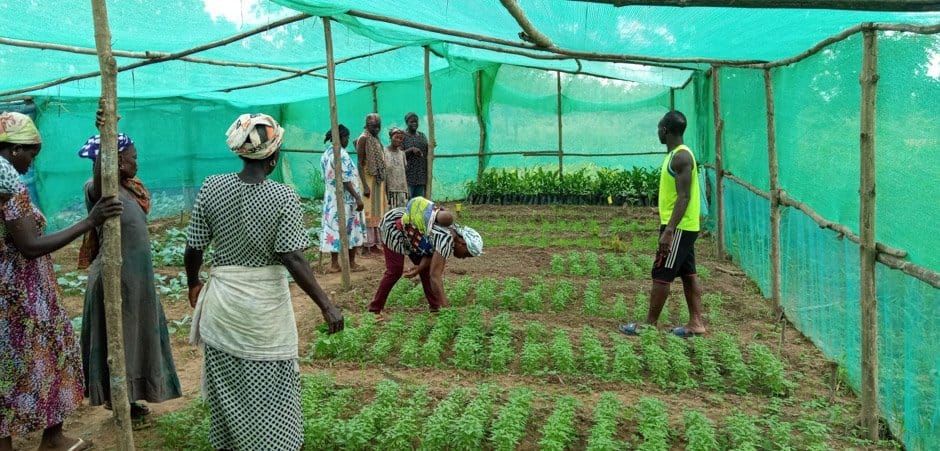
Convinced that trees are awesome? Help support the local community and entrepreneur school by planting a tree in Ghana right now.
Next Time With Click A Tree
So by now, you should have an introductory picture of what our tree-planting project in Ghana looks like.
The trees are part of a bigger cycle that will significantly benefit the area in the long-term. Workers have a stable, reliable, and full-time income. The fruits that are grown can be sold to help buy everyday essentials. And, on top of that, they support the (free) entrepreneur school, educating the next generation.
Animals are a crucial part of the cycle and all the while, larger trees are growing and creating new areas of forest.
As always, this work is only possible thanks to your help. Your bookings, your reservations, spreading the word to friends, family and co-workers, and remembering us when you organize a trip helps to fund this project and many others like it.
We’ll be sharing more from our work in Ghana soon. You’ll hear specific stories from the families whose lives have changed, and from the entrepreneur students who have new business ideas now.
In the meantime, sign-up for our GROW newsletter. We’ll plant a tree just to say thanks.
Tell your friends and family about Syntropic Farming. Look up how huge baobab trees grow to be! Perhaps you’ve been to Ghana before and want to tell us about your trip? Maybe you know somewhere else that we could help to reforest?
Whatever the reason, join in on our Facebook conversation about the Click A Tree projects in Ghana. Check out what else we’ve been up to on our Instagram account and enjoy some of the other articles on our blog, such as Elephant Tan Goes to Town.
Thanks for helping to make all of this possible, and stay tuned for the next update!